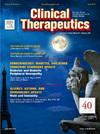Clinical Burden and Healthcare Resource Utilization Associated With Managing Transfusion-dependent β-Thalassemia in England
IF 3.2
4区 医学
Q2 PHARMACOLOGY & PHARMACY
引用次数: 0
Abstract
Purpose
Patients with transfusion-dependent β-thalassemia (TDT) have reduced levels of β-globin, leading to ineffective erythropoiesis and iron overload. Patients with TDT depend on regular red blood cell transfusions (RBCTs) and iron chelation therapy for survival and management of disease- and treatment-related clinical complications. This study describes the clinical and economic burden in patients with TDT in England.
Methods
This longitudinal, retrospective study linked the Clinical Practice Research Datalink (CPRD) database with secondary care data from the Hospital Episode Statistics database to identify patients with a diagnosis of β-thalassemia between July 1, 2008, and June 30, 2018. Included patients had a diagnosis of β-thalassemia prior to the index date, ≥8 RBCTs per year for ≥2 consecutive years, and ≥1 year of follow-up data available from the index date. Each eligible patient was exact matched with up to 5 controls in the CPRD. Proportions of deaths and rates of mortality, acute and chronic complications, and healthcare resource utilization (HCRU) were calculated during the follow-up period.
Findings
Of 11,359 identified patients with β-thalassemia, 237 patients with TDT met the eligibility criteria and were matched with 1184 controls. The mean age at the index date was approximately 25 years in the patient and control groups. The proportion of deaths (7.17% vs 1.18%; P < 0.05) and mortality rate (1.19 deaths per 100 person-years vs 0.20 deaths per 100 person-years) were higher among patients with TDT compared to controls. Endocrine complications and bone disorders were the most prevalent complications among patients with TDT (58.23%) and included osteoporosis (29.11%), diabetes mellitus (28.27%), and hypopituitarism (28.27%). Patients with TDT had a mean of 13.62 RBCTs per patient per year (PPPY). HCRU was substantially higher among patients with TDT, wherein patients with TDT had higher rates of prescriptions recorded in primary care (24.09 vs 8.61 PPPY), outpatient visits (16.69 vs 1.31 PPPY), and inpatient hospitalizations (17.41 vs 0.24 PPPY) than controls. Inpatient hospitalizations were primarily <1 day, with 16.62 events PPPY lasting <1 day and 0.79 events PPPY lasting ≥1 day. Patients with TDT aged ≥18 years had increased rates of mortality, clinical complications, and HCRU than those aged <18 years.
Implications
Patients with TDT in England have higher mortality than matched controls, substantial disease-related clinical complications, and substantial HCRU. High mortality and clinical complications highlight the need for additional innovative therapies for TDT.
英格兰输血依赖型 β 地中海贫血症的临床负担和医疗资源使用情况。
目的:输血依赖型β地中海贫血(TDT)患者体内的β-球蛋白水平降低,导致红细胞生成障碍和铁超载。TDT 患者依靠定期输注红细胞(RBCT)和铁螯合疗法生存,并控制疾病和治疗相关的临床并发症。本研究描述了英格兰 TDT 患者的临床和经济负担:这项纵向回顾性研究将临床实践研究数据链(CPRD)数据库与医院事件统计数据库中的二级护理数据联系起来,以确定在 2008 年 7 月 1 日至 2018 年 6 月 30 日期间诊断为 β 地中海贫血症的患者。纳入的患者在指标日期之前已确诊为β地中海贫血,连续≥2年每年进行≥8次RBCT,且自指标日期起有≥1年的随访数据。每位符合条件的患者最多可与 CPRD 中的 5 个对照组进行精确配对。计算随访期间的死亡比例和死亡率、急性和慢性并发症以及医疗资源利用率(HCRU):在已确认的 11359 名β地中海贫血患者中,有 237 名 TDT 患者符合资格标准,并与 1184 名对照组患者进行了配对。患者组和对照组在指数日期的平均年龄约为 25 岁。与对照组相比,TDT 患者的死亡比例(7.17% 对 1.18%;P < 0.05)和死亡率(1.19 人/100 年对 0.20 人/100 年)均较高。内分泌并发症和骨骼疾病是 TDT 患者最常见的并发症(58.23%),包括骨质疏松症(29.11%)、糖尿病(28.27%)和垂体功能减退(28.27%)。TDT患者平均每人每年进行13.62次RBCT(PPPY)。TDT患者的HCRU显著高于对照组,其中TDT患者的初级保健处方记录率(24.09 vs 8.61 PPPY)、门诊就诊率(16.69 vs 1.31 PPPY)和住院就诊率(17.41 vs 0.24 PPPY)均高于对照组。住院治疗主要是影响:英格兰 TDT 患者的死亡率高于匹配的对照组,与疾病相关的临床并发症较多,HCRU 也较高。高死亡率和临床并发症凸显了对 TDT 采取更多创新疗法的必要性。
本文章由计算机程序翻译,如有差异,请以英文原文为准。
求助全文
约1分钟内获得全文
求助全文
来源期刊

Clinical therapeutics
医学-药学
CiteScore
6.00
自引率
3.10%
发文量
154
审稿时长
9 weeks
期刊介绍:
Clinical Therapeutics provides peer-reviewed, rapid publication of recent developments in drug and other therapies as well as in diagnostics, pharmacoeconomics, health policy, treatment outcomes, and innovations in drug and biologics research. In addition Clinical Therapeutics features updates on specific topics collated by expert Topic Editors. Clinical Therapeutics is read by a large international audience of scientists and clinicians in a variety of research, academic, and clinical practice settings. Articles are indexed by all major biomedical abstracting databases.
 求助内容:
求助内容: 应助结果提醒方式:
应助结果提醒方式:


